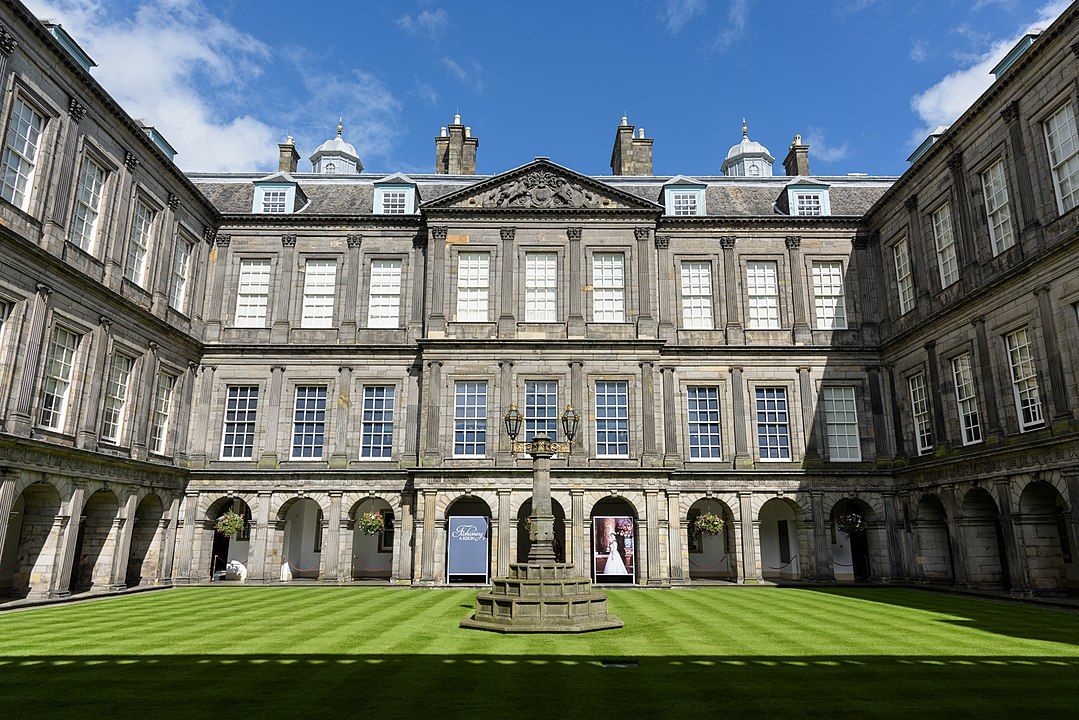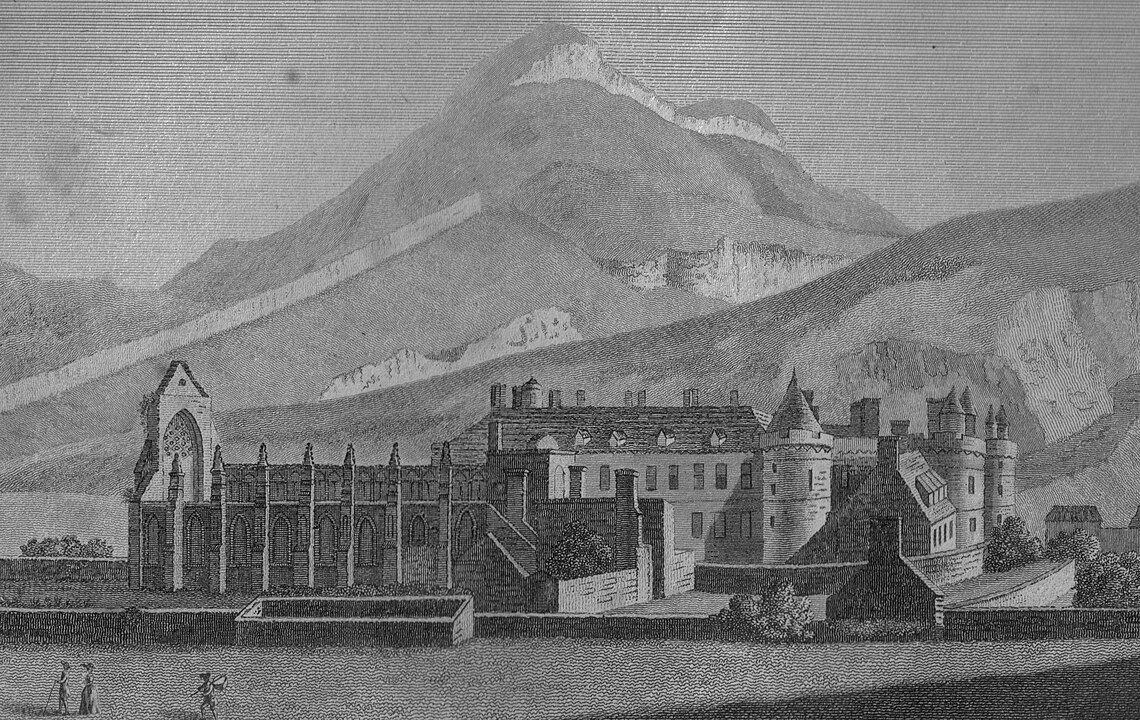Holyrood Palace or Holyroodhouse is the imposing official residence of the British Crown in Scotland. Placed at the end of the Royal Mile in Edinburgh, it has hosted kings and queens since the 1500s and it is one of the most interesting sites to be visited in town.
If you are intrigued by the history of Holyrood Palace and how to visit it, stay tuned and read this complete guide. Should you want even more, feel free to join one of our free tours and we will tell you everything about Edinburgh!

History of Holyrood Palace
The history of Holyrood Palace goes deep into the ruins of the namesake adjoining abbey founded in 1128 as an Augustinian house by command of the Scottish king David I. Owing to its location close to Edinburgh Castle, Holyrood Abbey soon became a hub of enormous administrative importance where the Parliament met and even the Treaty of Edinburgh-Northampton was signed in 1328, thus officially recognizing Scotland’s independence.
The building works of Holyrood Palace would get underway between 1501 and 1505 with the construction of a Gothic palace beside the abbey by command of James IV. During the Renaissance, the palace would expand its premises and grounds and it would host countless feasts and jaw-dropping jousts.
Holyrood Palace would thereupon be the preferred residence of Scotland’s queens and kings who would choose it instead of the old Edinburgh Castle. Behind its modern luxurious walls, monarchs such as James V, Mary Stuart, and James VI would dwell and rule. After the latter moved to London following the Union of the Crowns in 1603, Holyrood Palace would be stripped of its status as a permanent residence for the Crown and it would also lose most of its importance.
Having been ravaged by Oliver Cromwell’s army, Holyrood Palace would be rebuilt by King Charles II, but the 1707 Acts of Union between England and Scotland would usher its final fall into oblivion. Not until 1822 under the reign of George IV would its premises again host the visit of a British king. This and other subsequent rulers would luckily arrange for its repair and preservation, and today visitors can enjoy an indoor visit to many of its historical rooms.

Forefront historical figures
Many of the most relevant historical figures who have dropped by Holyrood Palace are Scottish kings and queens such as the famous Mary Stuart, George IV, or Elisabeth II herself, as well as her son, incumbent king Charles III.
The building has also lodged other personalities within its walls including Bonnie Prince Charlie, the “young pretender” who established an alternative royal court in the palace during the Jacobite uprising of 1745.
Some characters in recent history have also stayed in Holyrood Palace featuring Mikhail Gorbachev, Vladimir Putin, Nelson Mandela, Justin Trudeau, or Pope Benedict XVI.

Palace Architecture and Design
Holyrood Palace architecture as we see it today (with the exception of one of its towers which is older) is the work of architect Sir William Bruce who rebuilt the Renaissance landmark by command of Charles II between 1671 and 1678.
The palace design, in Neoclassical style, revolves around a square cloister-inspired three-storied yard, also featuring an attic and a main entrance framed by huge Doric columns.
The indoors of Holyrood Palace are distributed in two hundred and eighty-nine rooms, of which seventeen are open to the public. The private chambers of the incumbent royals are located on the second floor and they are off-limits.
Gardens and grounds
The Holyrood Palace grounds straddle around four hectares within the extensive nature area that is Holyrood Park. In them, many places of interest can be found such as the so-called “bathing house” of Mary Queen of Scots, a sundial from the 1600s, and an ornate 1800s fountain based upon the design of its Renaissance-era predecessor which is located in Linlithgow Palace. The grounds of Holyrood Palace are highly interesting and boast lovely views, do not miss out on them!

What to see in Holyrood Palace
You have all necessary information to plan your visit to Holyrood Palace here at the official website. The monument opens its doors to tourists all year round, but please bear in mind that you may find it closed to the public should the king stay there, so please check your dates on the website beforehand.
Royal abodes and stately furniture
The royal abodes are the most attractive area in Holyrood Palace. Therein you will be able to discover not only the breathtaking chambers where kings throughout the last two hundred years have carried out their receptions and feasts but also the genuine rooms where queen Mary Stuart lived, including furniture from her times and the place where her secretary David Rizzio was murdered.

The Great Gallery and Royal Portraits
In the Great Gallery, the largest chamber in Holyrood Palace, you will be able to admire almost one hundred portraits of Scottish rulers spanning throughout all history. A most curious place!
Holyrood Abbey
The ruins of Holyrood Abbey pose the oldest, most romantic element in Holyrood Palace.
Make sure to explore them and admire their imposing Gothic architecture!

Events and Exhibitions
Besides permanent collections, you can also enjoy events and exhibitions in Holyrood Palace. Here at the website, you can see what will be available during your trip dates.
Coming up in summer 2024 you will be able to enjoy private or themed tours with a guide, conferences, workshops for all ages, and photography and pictorial exhibitions.
Holyrood Palace and the Royal Family
Holyrood Palace is still an official residence of the British Royal Family. As the royal residence in Scotland, not only it has occasionally hosted British kings and queens themselves, but it has also been the stage of some of the most important royal events throughout the last few decades, such as the funeral for queen Elisabeth II in Scotland.
Useful information for your visit
Opening hours and admission fees
The opening hours at Holyrood Palace range from 09:30 to 18:00 during high season and until 16:30 in winter. The admission fee for an adult is £20 as long as it is booked online beforehand since purchasing it at the box office would cost you £22. This includes audio guides in different languages.
How to go and location
If you are wondering how to go to Holyrood Palace, it is as simple as reaching the end of the Royal Mile, the main hub in Edinburgh’s Old Town. There is no missing the location of Holyrood Palace!
Frequently Asked Questions
What is Holyrood Palace and where can it be found?
Holyrood Palace is located at the end of the Royal Mile in Edinburgh in the Old Town.What is the history of Holyrood Palace?
The history of Holyrood Palace goes deep into the ruins of the neighboring Augustinian abbey from the 1100s. The building of the palace would get underway later in the early 1500s.Which important historical figures have lived in Holyrood Palace?
Some of the historical figures in Holyrood Palace include King James V, Mary Queen of Scots, and her son James VI, and the Jacobite contender to the throne Bonnie Prince Charlie.What is Holyrood Palace architecture and design like?
The original architecture of Holyrood Palace dates back to the Renaissance era, but it was largely redesigned in Neoclassical style during the late 1600s.What is there to see and do in Holyrood Palace?
The best features of Holyrood Palace include its royal abodes, the Great Gallery, and the abbey ruins.Is Holyrood Palace still used by Britain’s royal family?
Indeed, the current use of Holyrood Palace includes the occasional presence of British royals within its premises, signaled by the hoisting of the Royal Banner.How long does it take to visit Holyrood Palace?
The duration of a visit to Holyrood Palace is around two hours.Can you take pictures indoors in the Palace?
No pictures can be taken inside Holyrood Palace, only in its grounds and in the abbey ruins.